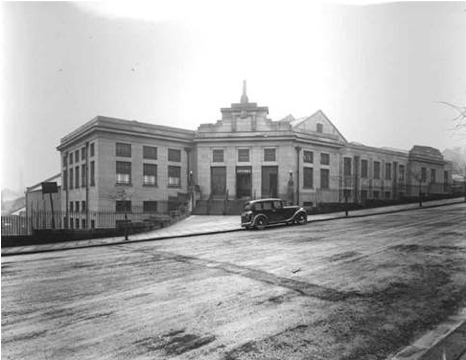Huddersfield (46 hours 30 minutes) – 30 Dec 1932 to 1 Jan 1933
Cambridge Road Baths
This was a repeat endurance swim in Huddersfield (the first being in April 1930), and it was reported in the press that Mercedes had set up the first sports record of 1933 when she completed the 46 hour 30 minute swim at half an hour past midnight on 1 January.
Postnatal swim
With this swim she continued to add her voice to the small number of women who at that time were slowly but surely disproving the preconception that women were physically unsuited or unable to take part in major sporting activity.
Mercedes again challenged this dogmatism by swimming continuously for 46 hours 30 minutes just two months after she had given birth – as, indeed, Katarina Nehua, the New Zealand swimmer, had done in the Manly Endurance Competition in Sydney in January 1931.

Photographer: Walter E. Turton
The swim took place in the relatively new Cambridge Road Baths which opened in August 1931, superseding the older Ramsden Street Baths where Mercedes had performed a 33-hour swim two and a half years earlier.
Reproduced courtesy of Kirklees Image Archives
She entered the water at 2.00 a.m. on Friday, 30 December 1932, swam through Saturday, 31 December, and finished at 12.30 a.m. on Sunday, 1 January 1933.
Those on poolside wishing her good luck included Councillor George Thorp, the Vice-Chairman of the Baths Committee, Arthur Robinson, the Baths Superintendent, Herbert Hardy, a swimming instructor, and most of the other members of staff. Later in the morning Alderman Willis, the Chairman of the Baths Committee, and a representative from the Huddersfield Daily Examiner
joined the growing crowd of spectators.
Music, which included selections from ‘The Bohemian Girl’, helped her along. The journalist on poolside interviewed Mercedes and she said to him: “Don’t forget to remind people to come along and sing to me tonight when I shall be entering upon the most difficult part of my swim.”
When asked how confident she was, she replied that if she was still in the water at 7 a.m. the following morning then she would be able to finish the swim. She estimated she was swimming at a rate of one mile per hour, maintaining an average of 26 strokes per minute. Her nourishment throughout the two days consisted of soup, beef tea, and coffee or water every half hour.
It was reported in the media that spectators had poured into the baths in the hours leading up to the finish and the roof rocked with the sound of the community singing of Daisy, Daisy, On Lindley Moor, and other popular songs. Councillor Wilfred Sizer arrived with his trumpet and provided a very powerful accompaniment to the roar. Excitement grew as midnight approached, and the singing of Auld Lang Syne heralded in the New Year. There was a storm of cheering and hand-clapping, and The Examiner
(2 January 1932) commented that:
The ovation probably had a dual significance: at once a spontaneous tribute to Miss Gleitze and an expression of relief that 1932, with all its anxious associations, was a thing of the past!
Thirty minutes later, at 12.30 a.m., Councillor Thorp announced that a new British record had been set. Mercedes was assisted out of the water, examined by the duty doctor and nurse, and then five minutes later taken by ambulance to the George Hotel, tired but delighted with her achievement.
At an interview the following morning the journalist found her none the worse for her experience. She said she felt fine – “as though I had not been swimming at all.” She told him that the most thrilling moment was when she swam into the New Year. This was the fourth consecutive time she had done this – the previous occasions being 1929 to 30 in Edinburgh; 1930 to 31 in Wellington, New Zealand; and in 1931 to 32 at Rotherham.
A total of 3,690 people watched Mercedes on this, her penultimate endurance swim.